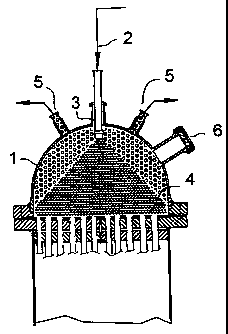Some of the information on this Web page has been provided by external sources. The Government of Canada is not responsible for the accuracy, reliability or currency of the information supplied by external sources. Users wishing to rely upon this information should consult directly with the source of the information. Content provided by external sources is not subject to official languages, privacy and accessibility requirements.
Any discrepancies in the text and image of the Claims and Abstract are due to differing posting times. Text of the Claims and Abstract are posted:
| (12) Patent: | (11) CA 2349166 |
|---|---|
| (54) English Title: | METHOD AND DEVICE FOR TREATING WATER FOR EVAPORATION |
| (54) French Title: | PROCEDE ET DISPOSITIF PERMETTANT DE TRAITER L'EAU EN VUE DE SON EVAPORATION |
| Status: | Term Expired - Post Grant Beyond Limit |
| (51) International Patent Classification (IPC): |
|
|---|---|
| (72) Inventors : |
|
| (73) Owners : |
|
| (71) Applicants : |
|
| (74) Agent: | PIASETZKI NENNIGER KVAS LLP |
| (74) Associate agent: | |
| (45) Issued: | 2008-02-19 |
| (86) PCT Filing Date: | 1999-11-08 |
| (87) Open to Public Inspection: | 2000-05-18 |
| Examination requested: | 2004-08-25 |
| Availability of licence: | N/A |
| Dedicated to the Public: | N/A |
| (25) Language of filing: | English |
| Patent Cooperation Treaty (PCT): | Yes |
|---|---|
| (86) PCT Filing Number: | PCT/FI1999/000928 |
| (87) International Publication Number: | FI1999000928 |
| (85) National Entry: | 2001-05-07 |
| (30) Application Priority Data: | ||||||
|---|---|---|---|---|---|---|
|
In the production of water vapor, particularly
in the production of especially clean water vapor,
dissolved gases, mainly atmospheric gases, are removed
from feed water. The feed water is sprayed by a spray
nozzle mounted in a hemispherical chamber in a spray
pattern which matches an area of an upper end of an
arrangement of vertical feed tubes of a falling film
evaporator. The dissolved gases are liberated quickly
from the sprayed droplets and removed through outlets in
the hemispherical chamber. The sprayed droplets collect
at the upper ends of the vertical evaporation channels
and are distributed evenly thereamong before atmospheric
gases can be redissolved.
Pour la production de vapeur d'eau, notamment pour la production de vapeur particulièrement propre, il faut absolument éliminer les gaz dissous dans l'eau d'alimentation, qui sont surtout des gaz atmosphériques. Quand on utilise un évaporateur à ruissellement, il est important de répartir uniformément l'eau d'alimentation sur les surfaces de transfert thermique. Avec le procédé et le dispositif de l'invention, le dégazage et la répartition uniforme de l'eau se font simultanément lors de la vaporisation de l'eau sur la partie supérieure de l'ensemble canal de transfert thermique, d'une manière uniforme, de façon à former de fines gouttelettes. Les gaz peuvent s'échapper rapidement de ces gouttelettes et ils n'ont pas le temps de se redissoudre, du fait que le processus d'évaporation commence immédiatement.
Note: Claims are shown in the official language in which they were submitted.
Note: Descriptions are shown in the official language in which they were submitted.

2024-08-01:As part of the Next Generation Patents (NGP) transition, the Canadian Patents Database (CPD) now contains a more detailed Event History, which replicates the Event Log of our new back-office solution.
Please note that "Inactive:" events refers to events no longer in use in our new back-office solution.
For a clearer understanding of the status of the application/patent presented on this page, the site Disclaimer , as well as the definitions for Patent , Event History , Maintenance Fee and Payment History should be consulted.
| Description | Date |
|---|---|
| Inactive: Expired (new Act pat) | 2019-11-08 |
| Common Representative Appointed | 2019-10-30 |
| Common Representative Appointed | 2019-10-30 |
| Grant by Issuance | 2008-02-19 |
| Inactive: Cover page published | 2008-02-18 |
| Inactive: Final fee received | 2007-12-07 |
| Pre-grant | 2007-12-07 |
| Notice of Allowance is Issued | 2007-09-04 |
| Letter Sent | 2007-09-04 |
| Notice of Allowance is Issued | 2007-09-04 |
| Inactive: Approved for allowance (AFA) | 2007-08-09 |
| Amendment Received - Voluntary Amendment | 2007-06-14 |
| Inactive: S.30(2) Rules - Examiner requisition | 2007-04-23 |
| Inactive: IPC from MCD | 2006-03-12 |
| Inactive: IPC from MCD | 2006-03-12 |
| Letter Sent | 2004-09-14 |
| Request for Examination Received | 2004-08-25 |
| Request for Examination Requirements Determined Compliant | 2004-08-25 |
| All Requirements for Examination Determined Compliant | 2004-08-25 |
| Inactive: Cover page published | 2001-09-19 |
| Inactive: First IPC assigned | 2001-08-07 |
| Inactive: Notice - National entry - No RFE | 2001-07-18 |
| Letter Sent | 2001-07-18 |
| Application Received - PCT | 2001-06-30 |
| Amendment Received - Voluntary Amendment | 2001-05-07 |
| Application Published (Open to Public Inspection) | 2000-05-18 |
There is no abandonment history.
The last payment was received on 2007-10-19
Note : If the full payment has not been received on or before the date indicated, a further fee may be required which may be one of the following
Patent fees are adjusted on the 1st of January every year. The amounts above are the current amounts if received by December 31 of the current year.
Please refer to the CIPO
Patent Fees
web page to see all current fee amounts.
Note: Records showing the ownership history in alphabetical order.
| Current Owners on Record |
|---|
| STERIS EUROPE, INC. SUOMEN SIVULIIKE |
| Past Owners on Record |
|---|
| MAURI SALMISUO |